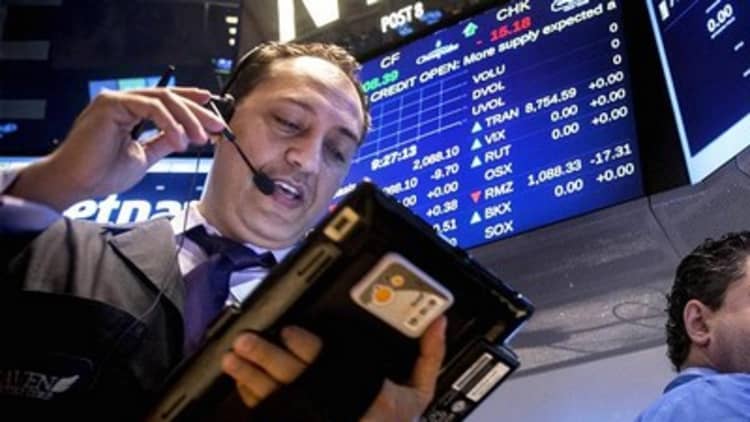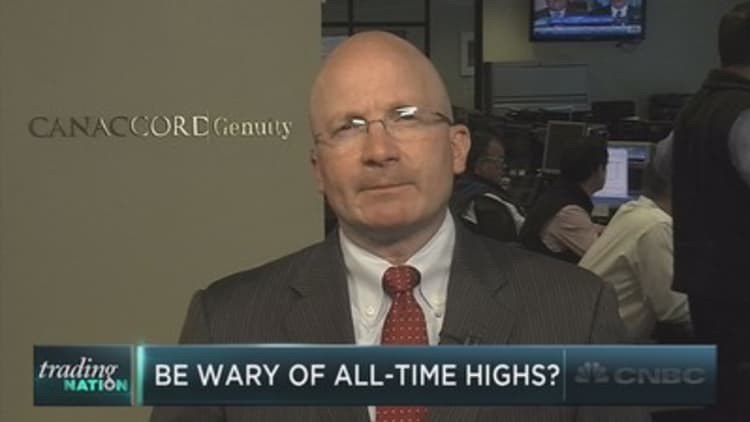
The S&P 500 broke through the top of its recent range with room to spare, signaling to some that a short-term rally may be at hand.
"On a technical basis, the fact we finally broke above 2,120, which we just could not penetrate, was pretty bullish, and now we have to trade around and test it. That's what this week may be about," said Gina Martin Adams, institutional equities strategist at Wells Fargo Securities.
"To get up to 2,130 is pretty bullish. We've broken the ceiling on that range, and that ceiling existed for several months." The S&P hit an intraday high of 2,131.

Traders have been watching for a breakout in the S&P, and now that it's here, there was also talk that the stock market is feeling toppy. Both the Dow and S&P 500 closed at all-time highs. The Dow was up 26 at 18,298, and the S&P 500 added 6 to 2,129 for a three-day gain of more than 1 percent.
For Tuesday's markets, there is housing starts data at 8:30 a.m. ET, and a number of big retailers reporting earnings, including Wal-Mart and Home Depot before the opening bell.
Mark Luschini, chief investment strategist at Janney Montgomery, also said the fact the S&P sauntered above 2,120 was a positive for the overall market. "Just given the fact the market seems to not want to go down, I would have to say my bias is to think the market continues to grind higher," he said.
Read More'Twilight zone' market could see big correction: Strategist
Adams said one factor in the market's favor is the low level of enthusiasm. "It doesn't feel good at all. Although we're at new highs, we haven't shot up there like a rocket. It hasn't been easy. Sentiment is still a little skeptical. (Investors) are not so excited about equities right now," Adams said.
"It doesn't feel good to be in equities," she said. "It's an interesting environment. The earnings season was remarkably strong, considering where we were in oil prices," which were 50 percent off their peak in early March. She said first-quarter earnings for the S&P 500 companies, without energy, rose 7.5 percent, and with energy companies climbed 1.5 percent though initially a decline in profits was expected.
Read MoreEl-Erian: Markets underestimating liquidity risk
Adams said a major positive is that oil prices reversed course, and the dollar has stopped its one-way race higher.
"The sentiment now is so negative," she said. "I'm not saying the earnings or the economy are blowing the cover off the ball. There's always a risk the Fed dismantles my thesis. There's always a policy risk, and this is an environment where we just don't know what to expect," she said.
Adams said she still expects the Fed to raise rates in September even though the recent batch of weak second-quarter data has caused some traders to push back expectations for the first rate hike to January or later.
The stock market's push through previous records comes as some analysts are sending out warnings that the summer may be a choppy time for stocks as markets watch the Fed move toward a rate increase decision.
Read MoreGoldman Sachs: Market's going nowhere for a year
"We were stalled at the 2,120 level, and the market seemed to hesitate at that level, which implied there was a line of resistance at that all-time high. (That) begged the question of what was the catalyst," Luschini said. "Low and behold, suddenly we moved up about 8 points to 2,031, not yet to suggest the all-clear signal has been given, but importantly to say the market can now look at the 2,120 level in the rearview mirror."
Treasury yields, which spooked stocks in recent sessions, continued to move higher Monday. The 10-year yield was at 2.23 percent in late trading.
"The bond market fell out of bed in the last couple of weeks. Any time the bond market starts to go a little bananas, and the equity market seems stable, you have to wonder what's going on out there. Nobody wants equities. They're moving into equities slowly because they don't want bonds," Adams said.
George Goncalves, head of rate strategy at Nomura, said one factor driving bond yields higher Monday was the burst of corporate bond issuance. There was $18 billion in corporate issuance Monday, including deals from Siemens, McDonald's, Credit Suisse, American Tower and Emerson Electric, according to Informa Global Markets.
Corporate issuance often weighs on Treasurys as investors sell to clear space for more corporate issues, and use the Treasury market to hedge. Another batch of corporate offerings is expected Tuesday, and issuance for this month of $115 billion is on track as the second busiest May ever.
Tuesday's housing data are the only economic report expected. Housing will be important later in the week when existing home sales are released Thursday. Other big headlines will be the Fed's meeting minutes Wednesday afternoon and CPI on Friday.
"You definitely want to see any sign of real activity, turning the corner post-winter," said Goncalves, noting traders will watch to see whether housing shows signs of health. "(Housing starts) used to matter less but now we're seeing other parts of the economy doing less well." Economists expect to see a more than 9 percent increase in housing starts, and a more than 1 percent rise in building permits.
Goncalves said the course of least resistance for yields was higher Monday, and data will help decide the direction. "Traders) are not going to step in front of any major moves unless there's more legs to it. It's hard to call tops. It's similar to calling bottoms. If the data were to continue to improve significantly and the Fed opens the window for September, yes we would see higher rates."
The Fed will use the next six weeks to make a call, he said. "If the data doesn't turn fast enough and stay consistently strong in the summer, they're not just going to take one data point. It's got to be two-three months in a row so it has to start turning now," Goncalves said.
Traders betting on interest rate hikes with the fed funds futures have dramatically reduced odds for a September hike and the odds of the first rate increase in early 2016 have risen. "The traders that are pricing out the Fed completely, they're viewing it as two discrete kinds of outcomes. What we need to think about in terms of Fed policy is the liftoff, and then how fast they're going to go," he said.
Besides Wal-Mart, earnings are also expected from TJX Cos, Red Robin Gourmet Burgers, Dick's Sporting Goods, Vodafone, Autodesk, Computer Sciences, Etsy, Nordson, and Analog Devices.


